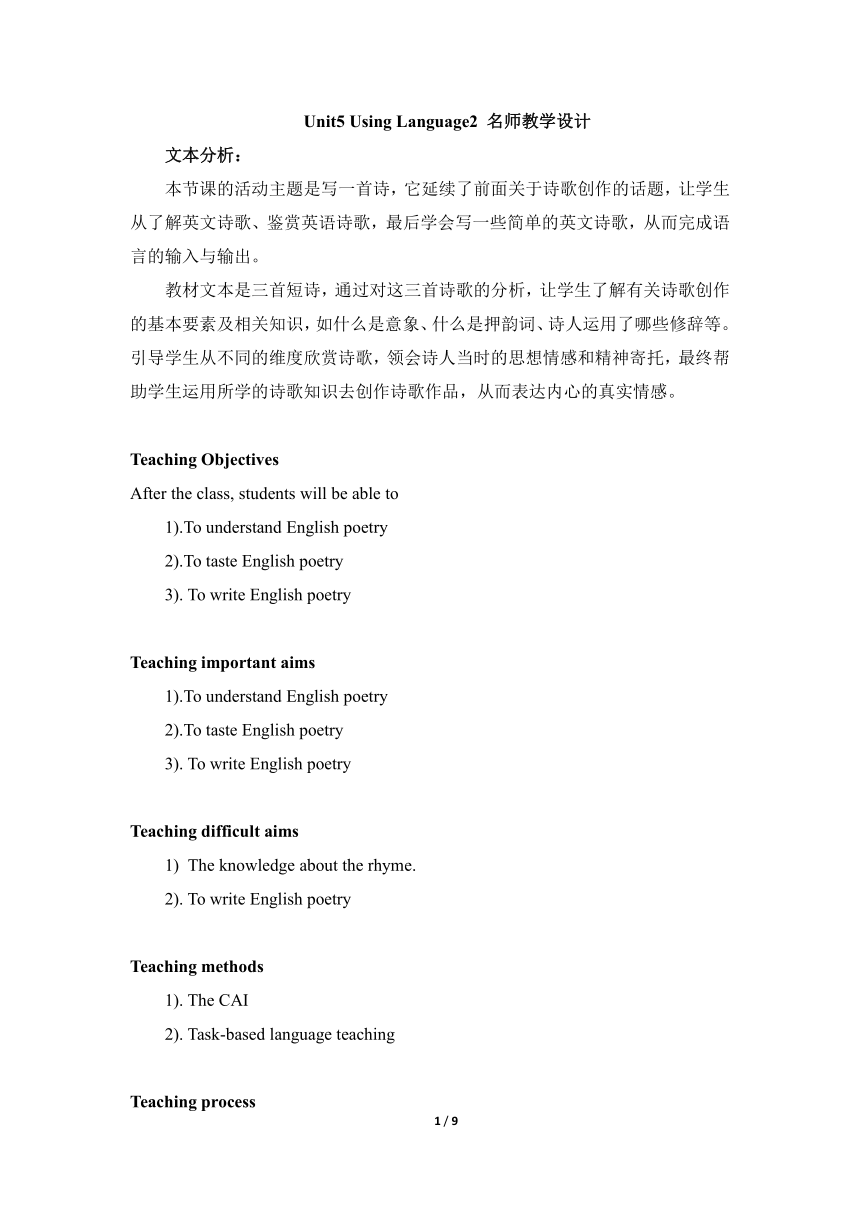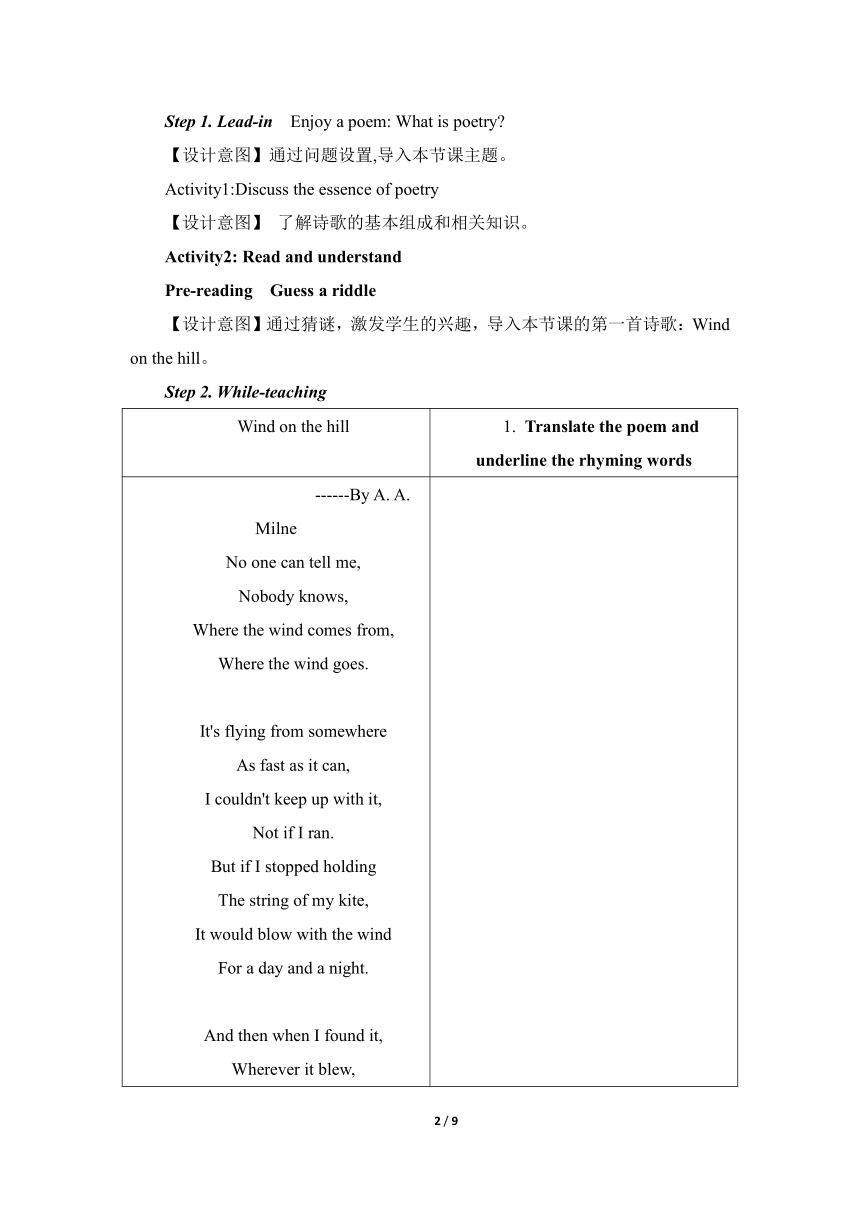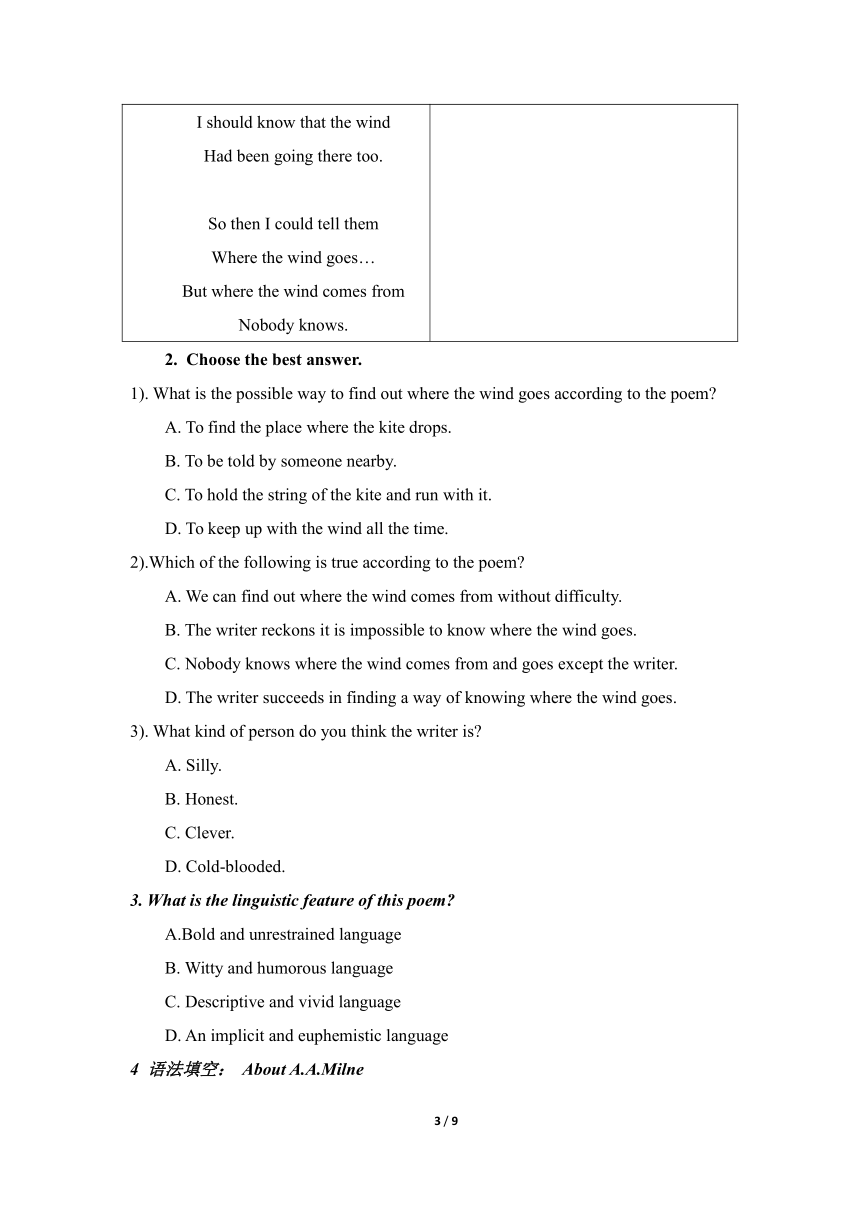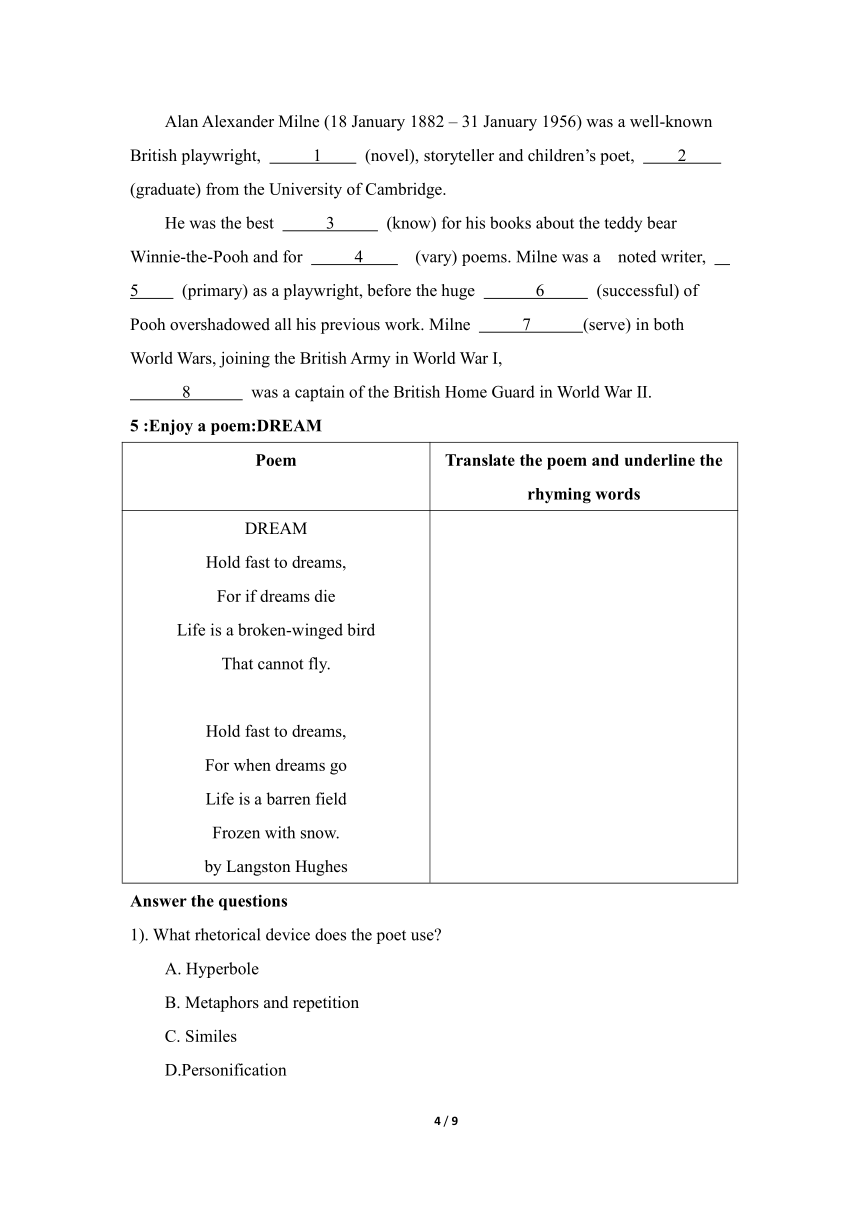人教版(2019)选择性必修第三册 Unit5 Poems Using Language2 名师教学设计
文档属性
| 名称 | 人教版(2019)选择性必修第三册 Unit5 Poems Using Language2 名师教学设计 |  | |
| 格式 | docx | ||
| 文件大小 | 24.1KB | ||
| 资源类型 | 教案 | ||
| 版本资源 | 人教版(2019) | ||
| 科目 | 英语 | ||
| 更新时间 | 2023-03-13 22:37:31 | ||
图片预览




文档简介
Unit5 Using Language2 名师教学设计
文本分析:
本节课的活动主题是写一首诗,它延续了前面关于诗歌创作的话题,让学生从了解英文诗歌、鉴赏英语诗歌,最后学会写一些简单的英文诗歌,从而完成语言的输入与输出。
教材文本是三首短诗,通过对这三首诗歌的分析,让学生了解有关诗歌创作的基本要素及相关知识,如什么是意象、什么是押韵词、诗人运用了哪些修辞等。引导学生从不同的维度欣赏诗歌,领会诗人当时的思想情感和精神寄托,最终帮助学生运用所学的诗歌知识去创作诗歌作品,从而表达内心的真实情感。
Teaching Objectives
After the class, students will be able to
1).To understand English poetry
2).To taste English poetry
3). To write English poetry
Teaching important aims
1).To understand English poetry
2).To taste English poetry
3). To write English poetry
Teaching difficult aims
The knowledge about the rhyme.
2). To write English poetry
Teaching methods
1). The CAI
2). Task-based language teaching
Teaching process
Step 1. Lead-in Enjoy a poem: What is poetry
【设计意图】通过问题设置,导入本节课主题。
Activity1:Discuss the essence of poetry
【设计意图】 了解诗歌的基本组成和相关知识。
Activity2: Read and understand
Pre-reading Guess a riddle
【设计意图】通过猜谜,激发学生的兴趣,导入本节课的第一首诗歌:Wind on the hill。
Step 2. While-teaching
Wind on the hill Translate the poem and underline the rhyming words
------By A. A. Milne No one can tell me, Nobody knows, Where the wind comes from, Where the wind goes. It's flying from somewhere As fast as it can, I couldn't keep up with it, Not if I ran. But if I stopped holding The string of my kite, It would blow with the wind For a day and a night. And then when I found it, Wherever it blew, I should know that the wind Had been going there too. So then I could tell them Where the wind goes… But where the wind comes from Nobody knows.
Choose the best answer.
1). What is the possible way to find out where the wind goes according to the poem
A. To find the place where the kite drops.
B. To be told by someone nearby.
C. To hold the string of the kite and run with it.
D. To keep up with the wind all the time.
2).Which of the following is true according to the poem
A. We can find out where the wind comes from without difficulty.
B. The writer reckons it is impossible to know where the wind goes.
C. Nobody knows where the wind comes from and goes except the writer.
D. The writer succeeds in finding a way of knowing where the wind goes.
3). What kind of person do you think the writer is
A. Silly.
B. Honest.
C. Clever.
D. Cold-blooded.
3. What is the linguistic feature of this poem
A.Bold and unrestrained language
B. Witty and humorous language
C. Descriptive and vivid language
D. An implicit and euphemistic language
4 语法填空: About A.A.Milne
Alan Alexander Milne (18 January 1882 – 31 January 1956) was a well-known British playwright, 1 (novel), storyteller and children’s poet, 2 (graduate) from the University of Cambridge.
He was the best 3 (know) for his books about the teddy bear Winnie-the-Pooh and for 4 (vary) poems. Milne was a noted writer, 5 (primary) as a playwright, before the huge 6 (successful) of Pooh overshadowed all his previous work. Milne 7 (serve) in both World Wars, joining the British Army in World War I,
8 was a captain of the British Home Guard in World War II.
5 :Enjoy a poem:DREAM
Poem Translate the poem and underline the rhyming words
DREAM Hold fast to dreams, For if dreams die Life is a broken-winged bird That cannot fly. Hold fast to dreams, For when dreams go Life is a barren field Frozen with snow. by Langston Hughes
Answer the questions
1). What rhetorical device does the poet use
A. Hyperbole
B. Metaphors and repetition
C. Similes
D.Personification
2). What does the author compare the life without dreams to
A. A flying bird and a dreamy wilderness
B. A singing bird and barren field .
C. A broken bird and frozen sonw.
D. A bird with a broken wing and frozen wilderness.
6 : Enjoy a poem: A MATCH
POEM Translate the poem and underline the rhyming words
If love were what the rose is, And I were like the leaf, Our lives would grow together In sad or singing weather, Blown fields or flowerful closes, Green pleasure or gray grief; If love were what the rose is, And I were like the leaf. A.C. Swinburne
Complete the following questions
1. What is the poem A MATCH about
2. What does this poem express
What rhetorical device does the poet use
【设计意图】 通过对这三首诗歌的具体分析,让学生了解诗歌节有关诗歌的基本常识,帮助学生顺利完成Page57 Exercise 2。于此同时,让学生了解诗歌知识,为下面的写诗作铺垫。
7 : To finish the exercise on Page57
Activity3: To discuss from which aspects we should enjoy English poetry
Practice 1: Finish the Exercise 3 on Page 57
Practice 2. Choose one of the poems and write a short essay about it.
Practice 3: Put what you’ve learned to use
假如你是李华,你校的美国交换生Steven非常喜欢中国古诗,给你发了一封邮件,请你为他推荐一名诗人及他/她的代表作,并就诗歌内容做个简单的介绍。现请你给他回复,内容包括:
1. 推荐的诗人及其代表作;
2. 诗歌介绍(包括影响和意义);
3. 你对诗歌的评价。
注意:
1.词数80左右;
2.可以适当增加细节,以使行文连贯。
A wonderful start
我喜欢唐朝诗人李白的诗歌。
我想和你们分享一下我对李白诗歌的感受。
你认为李白的诗歌怎么样?
我很高兴地告诉你,我喜欢李白的诗歌。
A wonderful body
李白的《静夜思》是我最喜欢的诗歌之一,它优美的意境常常使我想到我远在家乡的亲人。
正如我们大家所知道的,李白是唐代伟大的浪漫主义诗人,被后人誉为“诗仙。
李白的诗歌在国内外都享有很高的声誉。
A wonderful ending
这是我读过的最有意义的诗歌 。
因此,我特向你推荐李白的诗歌。
我相信我的推荐不会让你失望的。
在我的推荐下,你一定会领略到李白诗歌的风采。
Students’ works
【设计意图】学以致用。
Activity4: Write your own poem.
Write an original poem based on what has been learnt in the unit.
Let’s end up with the lesson with a poem!
What is poetry
【设计意图】首尾呼应.进一步突出本节课主题。
2 / 2
文本分析:
本节课的活动主题是写一首诗,它延续了前面关于诗歌创作的话题,让学生从了解英文诗歌、鉴赏英语诗歌,最后学会写一些简单的英文诗歌,从而完成语言的输入与输出。
教材文本是三首短诗,通过对这三首诗歌的分析,让学生了解有关诗歌创作的基本要素及相关知识,如什么是意象、什么是押韵词、诗人运用了哪些修辞等。引导学生从不同的维度欣赏诗歌,领会诗人当时的思想情感和精神寄托,最终帮助学生运用所学的诗歌知识去创作诗歌作品,从而表达内心的真实情感。
Teaching Objectives
After the class, students will be able to
1).To understand English poetry
2).To taste English poetry
3). To write English poetry
Teaching important aims
1).To understand English poetry
2).To taste English poetry
3). To write English poetry
Teaching difficult aims
The knowledge about the rhyme.
2). To write English poetry
Teaching methods
1). The CAI
2). Task-based language teaching
Teaching process
Step 1. Lead-in Enjoy a poem: What is poetry
【设计意图】通过问题设置,导入本节课主题。
Activity1:Discuss the essence of poetry
【设计意图】 了解诗歌的基本组成和相关知识。
Activity2: Read and understand
Pre-reading Guess a riddle
【设计意图】通过猜谜,激发学生的兴趣,导入本节课的第一首诗歌:Wind on the hill。
Step 2. While-teaching
Wind on the hill Translate the poem and underline the rhyming words
------By A. A. Milne No one can tell me, Nobody knows, Where the wind comes from, Where the wind goes. It's flying from somewhere As fast as it can, I couldn't keep up with it, Not if I ran. But if I stopped holding The string of my kite, It would blow with the wind For a day and a night. And then when I found it, Wherever it blew, I should know that the wind Had been going there too. So then I could tell them Where the wind goes… But where the wind comes from Nobody knows.
Choose the best answer.
1). What is the possible way to find out where the wind goes according to the poem
A. To find the place where the kite drops.
B. To be told by someone nearby.
C. To hold the string of the kite and run with it.
D. To keep up with the wind all the time.
2).Which of the following is true according to the poem
A. We can find out where the wind comes from without difficulty.
B. The writer reckons it is impossible to know where the wind goes.
C. Nobody knows where the wind comes from and goes except the writer.
D. The writer succeeds in finding a way of knowing where the wind goes.
3). What kind of person do you think the writer is
A. Silly.
B. Honest.
C. Clever.
D. Cold-blooded.
3. What is the linguistic feature of this poem
A.Bold and unrestrained language
B. Witty and humorous language
C. Descriptive and vivid language
D. An implicit and euphemistic language
4 语法填空: About A.A.Milne
Alan Alexander Milne (18 January 1882 – 31 January 1956) was a well-known British playwright, 1 (novel), storyteller and children’s poet, 2 (graduate) from the University of Cambridge.
He was the best 3 (know) for his books about the teddy bear Winnie-the-Pooh and for 4 (vary) poems. Milne was a noted writer, 5 (primary) as a playwright, before the huge 6 (successful) of Pooh overshadowed all his previous work. Milne 7 (serve) in both World Wars, joining the British Army in World War I,
8 was a captain of the British Home Guard in World War II.
5 :Enjoy a poem:DREAM
Poem Translate the poem and underline the rhyming words
DREAM Hold fast to dreams, For if dreams die Life is a broken-winged bird That cannot fly. Hold fast to dreams, For when dreams go Life is a barren field Frozen with snow. by Langston Hughes
Answer the questions
1). What rhetorical device does the poet use
A. Hyperbole
B. Metaphors and repetition
C. Similes
D.Personification
2). What does the author compare the life without dreams to
A. A flying bird and a dreamy wilderness
B. A singing bird and barren field .
C. A broken bird and frozen sonw.
D. A bird with a broken wing and frozen wilderness.
6 : Enjoy a poem: A MATCH
POEM Translate the poem and underline the rhyming words
If love were what the rose is, And I were like the leaf, Our lives would grow together In sad or singing weather, Blown fields or flowerful closes, Green pleasure or gray grief; If love were what the rose is, And I were like the leaf. A.C. Swinburne
Complete the following questions
1. What is the poem A MATCH about
2. What does this poem express
What rhetorical device does the poet use
【设计意图】 通过对这三首诗歌的具体分析,让学生了解诗歌节有关诗歌的基本常识,帮助学生顺利完成Page57 Exercise 2。于此同时,让学生了解诗歌知识,为下面的写诗作铺垫。
7 : To finish the exercise on Page57
Activity3: To discuss from which aspects we should enjoy English poetry
Practice 1: Finish the Exercise 3 on Page 57
Practice 2. Choose one of the poems and write a short essay about it.
Practice 3: Put what you’ve learned to use
假如你是李华,你校的美国交换生Steven非常喜欢中国古诗,给你发了一封邮件,请你为他推荐一名诗人及他/她的代表作,并就诗歌内容做个简单的介绍。现请你给他回复,内容包括:
1. 推荐的诗人及其代表作;
2. 诗歌介绍(包括影响和意义);
3. 你对诗歌的评价。
注意:
1.词数80左右;
2.可以适当增加细节,以使行文连贯。
A wonderful start
我喜欢唐朝诗人李白的诗歌。
我想和你们分享一下我对李白诗歌的感受。
你认为李白的诗歌怎么样?
我很高兴地告诉你,我喜欢李白的诗歌。
A wonderful body
李白的《静夜思》是我最喜欢的诗歌之一,它优美的意境常常使我想到我远在家乡的亲人。
正如我们大家所知道的,李白是唐代伟大的浪漫主义诗人,被后人誉为“诗仙。
李白的诗歌在国内外都享有很高的声誉。
A wonderful ending
这是我读过的最有意义的诗歌 。
因此,我特向你推荐李白的诗歌。
我相信我的推荐不会让你失望的。
在我的推荐下,你一定会领略到李白诗歌的风采。
Students’ works
【设计意图】学以致用。
Activity4: Write your own poem.
Write an original poem based on what has been learnt in the unit.
Let’s end up with the lesson with a poem!
What is poetry
【设计意图】首尾呼应.进一步突出本节课主题。
2 / 2
